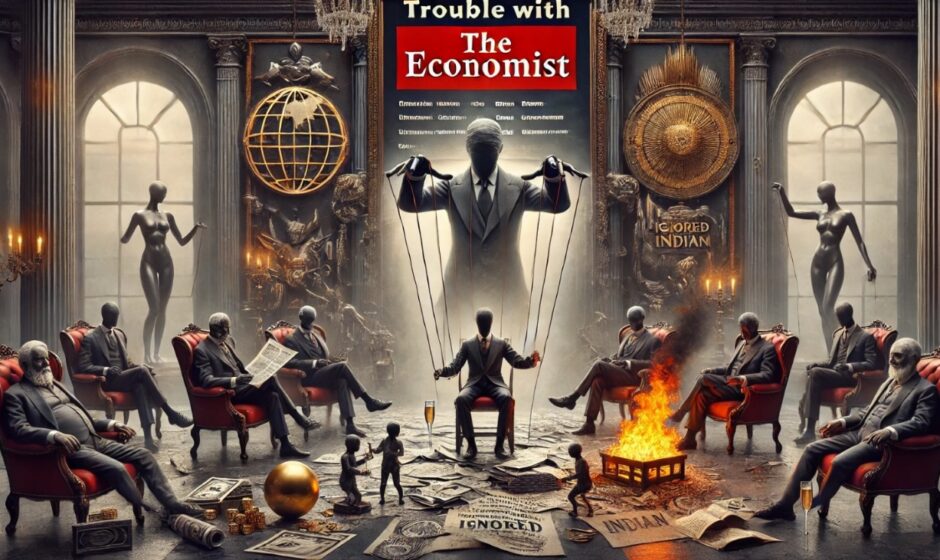Write-up on RSS is steeped in distortions, prejudices, agenda driven narrative push rather than nuanced analysis that stands scrutiny.
On December 19, 2024, as festive season approached, The Economist released its holiday double issue, featuring an unnamed article on Rashtriya Swayamsevak Sangh (RSS). The publication, owned by immensely wealthy Agnelli and Rothschild families, traces its origins to 1843, when it was founded to advocate for repeal of import tariffs.

Yet, in its long history, The Economist has strayed little from its original mission of pushing selective agendas cloaked in garb of intellectual rigour.
Over the years, it has subtly perfected the art of propaganda, blending curated narratives with psychological imprinting to advance the interests of its elite patrons.
This Christmas edition is no exception. Beneath the veneer of incisive commentary lies a carefully orchestrated exercise in bias—shaping perceptions to align with the ruling class worldview that The Economist so loyally upholds. Whether degrading communities or offering justifications for wars, the magazine has long operated as a conduit for dangerous and radical global agendas.
In this latest offering, the publication’s signature word crafting meets its predictable penchant for soft-pedaling propaganda, leaving readers with a polished but shallow narrative that serves its masters across oceans, rather than the truth it claims to champion. In its article titled “Inside the RSS: The World’s Most Powerful Group,” The Economist employs its arsenal of rhetoric to perpetuate a troubling narrative against what it perceives as a significant ideological opposition to its wealthy western ruling elite.
The elite, seemingly vested in a global order conducive to its own interests, appears to view Rashtriya Swayamsevak Sangh (RSS) as a formidable challenge. The article alleges that RSS is a paramilitary organization culpable for persecution of India’s post-partition minorities —a claim that rests on foundation of conjecture rather than tangible evidence. In reality, Bharat boasts a thriving minority landscape, some of the world’s most robust legal protections and welfare schemes for minorities, unparalleled in their scope and inclusivity.
At a time when Western corporations and elite amass fortunes from wars that devastate nations across the globe, Bharat’s ethos has consistently championed inclusivity, cultural oneness and wellness. The worldview embodied by the RSS—an organization that represents the world’s largest voluntary movement—is deeply rooted in this ancient Indian philosophy.
Far from the aggression suggested by The Economist, the RSS reflects a commitment to harmony and resilience, offering a counterpoint to exploitative frameworks perpetuated by those who profit from division and conflict. By choosing to distort rather than understand this ethos, The Economist exhibits its own inability—or unwillingness—to engage with perspectives that challenge the interests of its benefactors.
More so, in relentless pursuit of narrative control, The Economist once again attempts to link Nathuram Godse, the assassin of Mahatma Gandhi, to the RSS, describing him as an “ex-member” of the organization. This is a jaded agenda-based narrative that has had exposed RSS rivals. This very fixation not only underscores the publication’s penchant for propaganda but reveals a troubling reliance on conspiracy theories when they align with its agenda.
Interestingly, The Economist spares no effort in crafting curated narratives about others while maintaining a conspicuous silence on controversies closer to its own sphere of influence. The Rothschilds, for instance—a family whose immense wealth and influence have been the subject of countless theories, from the Kennedy assassination to the Islamic State—remain untouched by the magazine’s purported investigative zeal.
Similarly, the rumoured role of US government in assassination of Martin Luther King Jr. is conspicuously absent from its pages, despite widespread historic scrutiny. This selective focus speaks volumes about the publication’s biases and priorities. For those who can discern fact from fiction, The Economist’s approach serves as a reminder to distinguish credible media from outlets that prioritize agenda driven narratives over professional reportage. By choosing to amplify baseless charges against the RSS while ignoring deeper, systemic issues tied to its elite patrons, The Economist exposes its own limitations as a serious journalistic institution – which it tries to project itself.
Ironically, The Economist expects its readers to believe that the RSS draws inspiration from Hitler’s Nazi Germany—a claim that is as baseless as it is sensational. The narrative point that lost its shelf life in last couple of decades, undoubtedly was reborn in champagne circles and elite echo chambers and it fails to hold up against the reality experienced by millions across India.
From the youngest child to the eldest member of society, anyone who has encountered RSS firsthand can unequivocally attest to its true source of inspiration: the sacred Vedas, Upanishads and Sanatan Dharmic philosophy and outlook to Hindu way of life. Far from the twisted historical parallels The Economist seeks to draw, RSS is deeply rooted in timeless principles of Indian philosophy, centered on harmony, inclusivity, and selfless service. Such erroneous narratives find little resonance with the Indian population, who recognize them for what they are—attempts to vilify through misinformation.
Instead, they gain traction in controlled settings where carefully curated echo chambers are created, often with backing of media outfits like The Economist. By perpetuating these flawed depictions, the magazine reveals not just its bias, but also its disconnect from ethos of a nation it claims to critique.
In its relentless campaign against Bharat’s leadership, The Economist perpetuates baseless accusation that Prime Minister Narendra Modi bears responsibility for unfortunate Gujarat riots of 2002. This charge, however, crumbles under scrutiny, exposing not only its absurdity but also the Hinduphobic bias that underpins such narratives.
What The Economist conveniently omits—and what must be highlighted—is the inhumane and brutal burning alive of 59 Hindu kar sevaks (volunteers) aboard Sabarmati Express at Godhra. This act of terror, meticulously planned and coordinated by Islamist extremists, sparked the violence that followed. Among those convicted for orchestrating this atrocity were Maulvi Umarji, Farooq Bhana and Imran Sheru—a stark reminder of premeditated nature of the attack. Yet, this foundational context finds no mention in The Economist’s coverage, which prefers to portray Hindus as aggressors while absolving the instigators of their culpability.
The Gujarat riots, acknowledged by Bharat’s citizens as a national tragedy, are a somber reminder of the pain that communal violence inflicts on a nation. However, attributing the violence to Narendra Modi, then Chief Minister of Gujarat, has been thoroughly discredited. In 2022, after exhaustive investigations and legal proceedings spanning two decades, Supreme Court of India—a judiciary of unimpeachable integrity and competence, comparable in stature to United States Supreme Court—explicitly cleared Modi of any wrongdoing. The Court upheld the findings of a Special Investigation Team (SIT) that meticulously examined the events and found no evidence to support the allegations of complicity or negligence against him.
Communal riots, unfortunately, are not unique to India. Across the globe, such conflicts have been driven by discontent and mistrust, often rooted in historical grievances. However, selectively attributing these tragedies to specific leaders or groups, as The Economist does in Modi’s case, reveals a glaring double standard. By that logic, should countless race riots in United States, the systemic degradation of Native Americans or the internment of Japanese Americans during World War II be singularly blamed on specific leaders?
Such a selective approach to accountability serves no purpose but to perpetuate divisive narratives. It also ignores the root causes of violence—in this case, Islamist religious hatred that led to Godhra attack—and the systemic challenges that nations face in fostering communal harmony. Rather than engaging in constructive dialogue or meaningful critique, The Economist opts for a simplistic narrative that unfairly vilifies an individual while ignoring broader realities of the tragedy.
This reductive storytelling not only undermines its credibility as a global publication but also insults the intelligence of its readers, who deserve a fair and balanced account of history, free from prejudice and ideological bias.
Lastly, the article by The Economist offers a poorly constructed echo chamber narrative, reflecting the shallow musings of armchair researchers rather than a genuine exploration of facts. From its baseless ideological claims of discontentment to its incoherent targeting of the RSS’s student and women’s wings, the contradictions are glaring. The article descends into absurdity when it alleges RSS excludes women, only to contradict itself by acknowledging the organization’s thriving women’s wings, such as the Rashtra Sevika Samiti. These inconsistencies expose lack of intellectual rigour and willingness to compromise accuracy for sake of sensationalism.
This critique of RSS, an organization deeply rooted in India’s civilizational ethos of inclusivity and selfless service, reeks of an outdated colonial mindset that views non-Western systems with skepticism and condescension. For nearly a century, the RSS has contributed to nation-building, from organising disaster relief to fostering educational initiatives that promote harmony. Yet, The Economist, seemingly oblivious to these contributions, chooses to caricature the organization through cherry-picked narratives designed to align with the ideological biases of its elite benefactors.
The Christmas edition is a stark reflection of The Economist’s enduring compulsion to curate narratives that serve wealthy families in Western hemisphere steering its editorial policies. By presenting a narrow, one-sided portrayal of RSS, the publication not only fails to inform its readers but also demonstrates a deliberate disregard for complex realities of Indian society. Furthermore, the attempt to frame RSS’s ideology as somehow inspired by fascist principles is both historically inaccurate and deeply offensive, ignoring the organization’s foundational philosophy rooted in the sacred Vedas, Upanishads, Dharmic philosophy, outlook and way of life and Bharat’s ancient traditions of pluralism and non-violence.
In conclusion, this article exemplifies The Economist’s tendency to prioritize propaganda over journalism. Its failure to acknowledge the tragic burning alive of 59 Hindu karsevaks at Godhra—a premeditated attack orchestrated by Islamist extremists—speaks volumes about its selective outrage and bias.
Tragedy of Gujarat riots notwithstanding, Bharat’s judiciary, including the Supreme Court, has unequivocally cleared Prime Minister Narendra Modi of any wrongdoing. In contrast, The Economist perpetuates discredited allegations, betraying its Hinduphobic bias while ignoring historical and legal truths. At a time when global audiences are more informed and discerning, such shallow attempts at ideological manipulation do little to advance meaningful discourse.
Instead, they alienate readers who demand balanced reporting and nuanced analysis. In this part of the world, where people have evolved to distinguish fact from propaganda, the publication’s outdated tactics hold little sway. This article, intended as a Christmas edition, serves not as thoughtful commentary but as a cautionary tale of the dangers of echo chambers and the erosion of journalistic integrity.Trouble with ‘The Economist’



